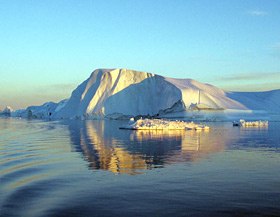 |
 |
 |
 Editorials | Environmental | March 2006 Editorials | Environmental | March 2006  
North Pole Meets South Pole: Earth Is Melting at Both Ends
 Bill Blakemore - ABC News Bill Blakemore - ABC News


| | The sun sets on the Ilulissat fiord, on Greenland's western coast. (Slim Allagui/AFP) |
For the first time, scientists have confirmed Earth is melting at both ends, which could have disastrous effects for coastal cities and villages.

Antarctica has been called "a slumbering giant" by a climate scientist who predicts that if all the ice melted, sea levels would rise by 200 feet. Other scientists believe that such a thing won't happen, but new studies show that the slumbering giant has started to stir.

Recent studies have confirmed that the North Pole and the South Pole have started melting.

Experts have long predicted that global warming would start to melt Greenland's two-mile-thick ice sheet, but they also thought the more massive ice sheet covering Antarctica would increase in the 21st century.

It seems they were wrong.

Two new studies find that despite the increasing snowfall that comes with global warming as a result of the increased moisture in the air, Antarctica's ice sheets are losing far more than the snow is adding.

According to the National Academy of Sciences, Earth's surface temperature has risen by about 1 degree Fahrenheit in the last century, with accelerated warming during the last two decades. Most of the warming over the last 50 years is attributable to human activities through the buildup of greenhouse gases - primarily carbon dioxide, methane and nitrous oxide. Although the heat-trapping property of these gases is undisputed, uncertainties exist about exactly how Earth's climate responds to them.

"The warming ocean comes underneath the ice shelves and melts them from the bottom, and warmer air from the top melts them from the top," said NASA glaciologist Jay Zwally. "So they're thinning and eventually they get to a point where they go poof!"

Zwally explains that the ice shelves, which the Antarctic ice cap pushes out into the ocean, are responding more than they expected to Earth's warming air and water. If the melting speeds up to a rapid runaway process called a "collapse," coastal cities and villages could be in danger.

James Hansen, director of NASA's Earth Science Research, said that disaster could probably be avoided, but that it would require dramatically cutting emission outputs. If the proper actions aren't taken, Hansen said, the sea level could rise as much as 80 feet by the time today's children reach middle age.

"We now must choose between a serious problem that we can probably handle and, if we don't act soon, unmitigated disaster down the road," Hansen said.

Scientists looking at ice cores can now read Earth's temperatures from past millennia and match them to sea levels from those eras.

"Based on the history of the Earth, if we can keep the warming less than 2 degrees Fahrenheit, I think we can avoid disastrous ice sheet collapse," Hansen said.

Hansen and other scientists point out that a rise of at least 1 degree Fahrenheit - and another few feet of sea level - seem virtually certain to happen because of the carbon that mankind has already put in the atmosphere. | 
 | |
 |



